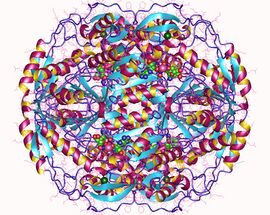Biology:Aldehyde dehydrogenase (NAD+)
| aldehyde dehydrogenase (NAD) | |||||||||
|---|---|---|---|---|---|---|---|---|---|
 Aldehyde dehydrogenase tetramer, Human | |||||||||
| Identifiers | |||||||||
| EC number | 1.2.1.3 | ||||||||
| CAS number | 9028-86-8 | ||||||||
| Databases | |||||||||
| IntEnz | IntEnz view | ||||||||
| BRENDA | BRENDA entry | ||||||||
| ExPASy | NiceZyme view | ||||||||
| KEGG | KEGG entry | ||||||||
| MetaCyc | metabolic pathway | ||||||||
| PRIAM | profile | ||||||||
| PDB structures | RCSB PDB PDBe PDBsum | ||||||||
| Gene Ontology | AmiGO / QuickGO | ||||||||
| |||||||||
In enzymology, an aldehyde dehydrogenase (NAD+) (EC 1.2.1.3) is an enzyme that catalyzes the chemical reaction
- an aldehyde + NAD+ + H2O [math]\displaystyle{ \rightleftharpoons }[/math] an acid + NADH + H+
The 3 substrates of this enzyme are aldehyde, NAD+, and H2O, whereas its 3 products are acid, NADH, and H+.
This enzyme belongs to the family of oxidoreductases, specifically those acting on the aldehyde or oxo group of donor with NAD+ or NADP+ as acceptor. The systematic name of this enzyme class is aldehyde:NAD+ oxidoreductase. Other names in common use include CoA-independent aldehyde dehydrogenase, m-methylbenzaldehyde dehydrogenase, NAD-aldehyde dehydrogenase, NAD-dependent 4-hydroxynonenal dehydrogenase, NAD-dependent aldehyde dehydrogenase, NAD-linked aldehyde dehydrogenase, propionaldehyde dehydrogenase, and aldehyde dehydrogenase (NAD). This enzyme participates in 17 metabolic pathways: glycolysis / gluconeogenesis, ascorbate and aldarate metabolism, fatty acid metabolism, bile acid biosynthesis, urea cycle and metabolism of amino groups, valine, leucine and isoleucine degradation, lysine degradation, histidine metabolism, tryptophan metabolism, beta-alanine metabolism, glycerolipid metabolism, pyruvate metabolism, 1,2-dichloroethane degradation, propanoate metabolism, 3-chloroacrylic acid degradation, butanoate metabolism, and limonene and pinene degradation.
References
- The Enzymes. 7 (2nd ed.). New York: Academic Press. 1963. pp. 203–221.
- "Aldehyde dehydrogenase, a diphosphopyridine nucleotide-linked enzyme". The Journal of Biological Chemistry 177 (2): 883–92. February 1949. PMID 18110463. http://www.jbc.org/content/177/2/883.full.pdf.
External links
- "Anti-ageing compound set for human trials after turning clock back for mice". The Guardian. https://www.theguardian.com/science/2013/dec/20/anti-ageing-human-trials.
- "Declining NAD(+) induces a pseudohypoxic state disrupting nuclear-mitochondrial communication during aging". Cell 155 (7): 1624–38. December 2013. doi:10.1016/j.cell.2013.11.037. PMID 24360282.
 |

